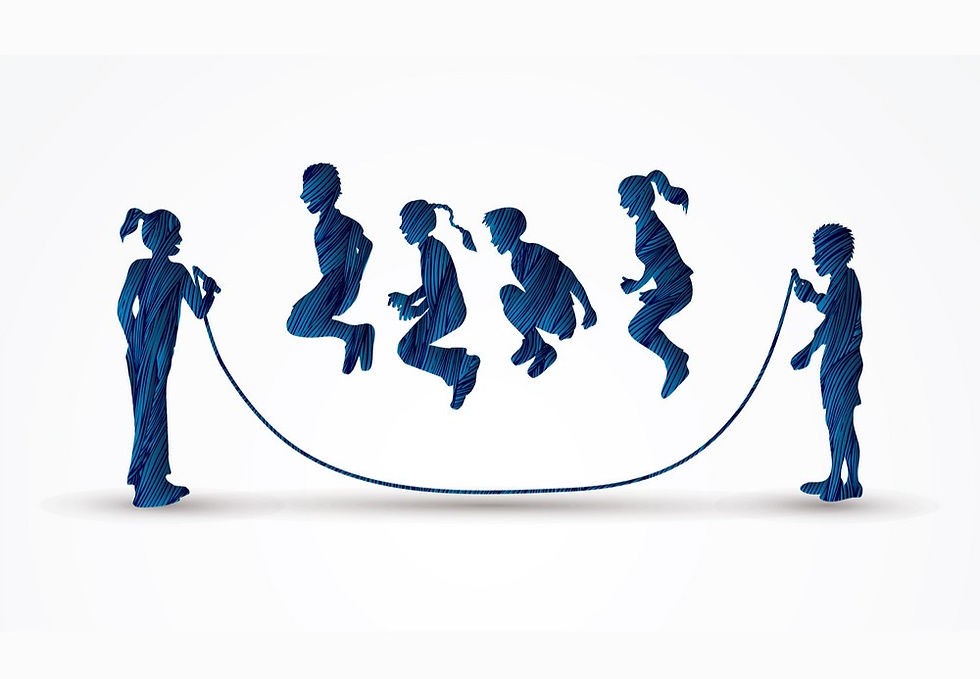Easy Plyometric training for Youth - Rope Skipping
- Nicholas H.K. Lam

- Nov 15, 2019
- 3 min read

What is the best plyometric training for children?
As an S&C graduate, I have been applying plyo-box, hurdle jump or even depth jump in my athletes' training program. We take training load, perceived exertion, delay onset of muscle soreness and many other issues into consideration i.e landing mechanism, knee alignment. However, less is more, particularly working with a big group of children.
If you are a physical education teacher, the following information may be useful for your students.
Let's get rid of those fancy equipment. All we need is just a rope.
Rope skipping is one of the training exercises commonly used to train adolescents in physical education lessons. According to Pittenger, McCaw and Thomas (2002), rope skipping has been used as a fundraising tool which involved over 3 million adolescents in the early century which explained the popularity and accessibility of jumping rope at school. Rope skipping is an exercise performed with jumping rope, which is a continuous rhythmical rebound jump movement including flexing and extending hip, knees and ankles while rotating the jumping rope above the head and under feet as well as maintaining the eye-hand coordination in order to perform a synchronized movement (Miyaguchi, Sugiura & Demura, 2014; Miyahuchi, Demura, & Omoya, 2015).
Plyometric training includes unilateral and bilateral jumping, bounding and hopping which requires pre-stretch and countermovement of the muscle in order to increase the response of stretch-shortening cycle (SSC) (Moran, Clark, Ramirez-Campillo, Davies, & Drury, 2018). Adolescents experience physiological changes in body size and musculotendinous junction during puberty. The ability to generate power from SSC is eliminated because of the structural change in body and the effect of the contractile mechanism of using the elastic energy in muscles (Sahrom, Cronin, & Harris, 2013). Rope skipping enhances the ability to generate power from the triple extension which involves ankles, knees and hip; these rapid rebound jumps are believed to be beneficial in training SSC in adolescent (Miyaguchi et al., 2014). Even those adolescents who undergo the middle phase of growth spurt are relatively less sensitive to plyometric training (Moran et al., 2017), it is arguable that these groups of athletes should not participate in plyometric training. However, rope skipping may be used as an alternative since it requires high neuromuscular control and these age groups of people lack the ability to generate power from SSC because of the structural changes in the body.
The most important element when designing a training program for youth - FUN. Rope skipping could be performed with a bunch of students, unlike traditional plyometric training. It creates a culture of teamwork in the class and promotes the all-round development of children.
Give it a try and see how your students respond to this!
References
Miyaguchi, K., Demura, S., & Omoya, M. (2015). Relationship Between Jump Rope Double Unders and Sprint Performance in Elementary Schoolchildren. Journal of Strength and Conditioning Research, 29(11), 3229-3233. doi:10.1519/JSC.0000000000000543
Miyaguchi, K., Sugiura, H., & Demura, S. (2014). Possibility of Stretch-Shortening Cycle Movement Training Using a Jump Rope. Journal of Strength and Conditioning Research, 28(3), 700-705. doi:10.1519/JSC.0b013e3182a0c9a5
Moran, J. J., Sandercock, R. H. G., Ramírez-Campillo, M. P. R., Meylan, A. C., Collison, A. J., & Parry, A. D. (2017). Age-Related Variation in Male Youth Athletesʼ Countermovement Jump After Plyometric Training: A Meta-Analysis of Controlled Trials. Journal of Strength and Conditioning Research, 31(2), 552-565. doi:10.1519/JSC.0000000000001444
Moran, C. T. J., Clark, J. C., Ramirez-Campillo, J. R., Davies, J. M., & Drury, J. B. (2018). A Meta-Analysis of Plyometric Training in Female Youth: Its Efficacy and Shortcomings in the Literature. Journal of Strength and Conditioning Research. doi:10.1519/JSC.0000000000002768
Pittenger, V., McCaw, S., & Thomas, D. (2002). Vertical ground reaction forces of children during one- and two-leg rope jumping. Research Quarterly for Exercise and Sport, 73(4), 445-449. doi:10.1080/02701367.2002.10609044
Sahrom, S. B., Cronin, J. B., & Harris, N. K. (2013). Understanding stretch shortening cycle ability in youth. Strength and Conditioning Journal, 35(3), 77-88. doi:10.1519/SSC.0b013e318295560a




Comments